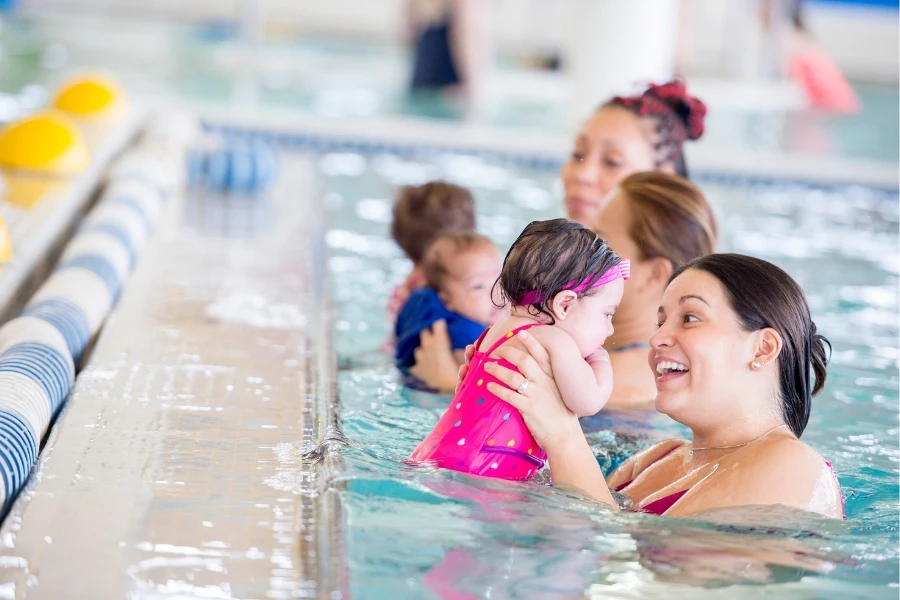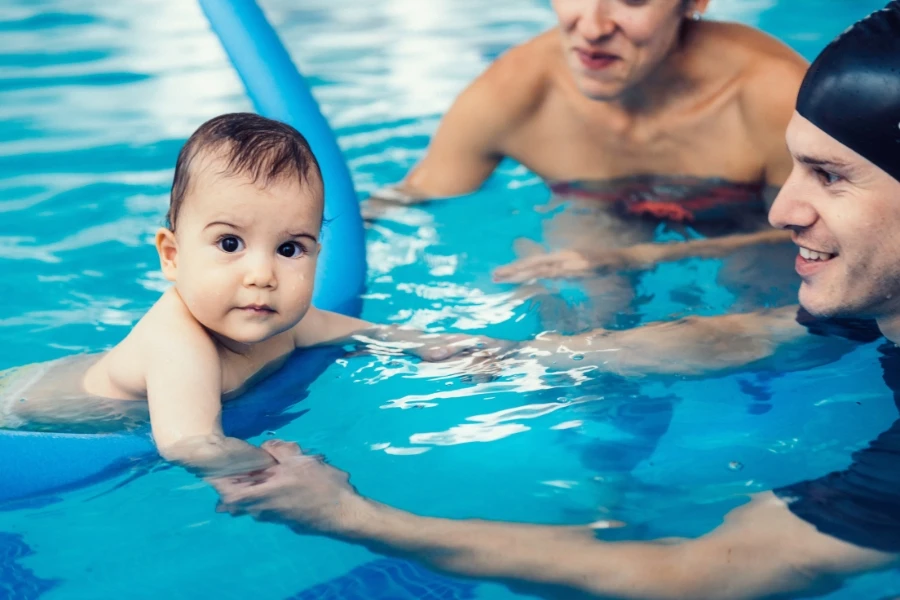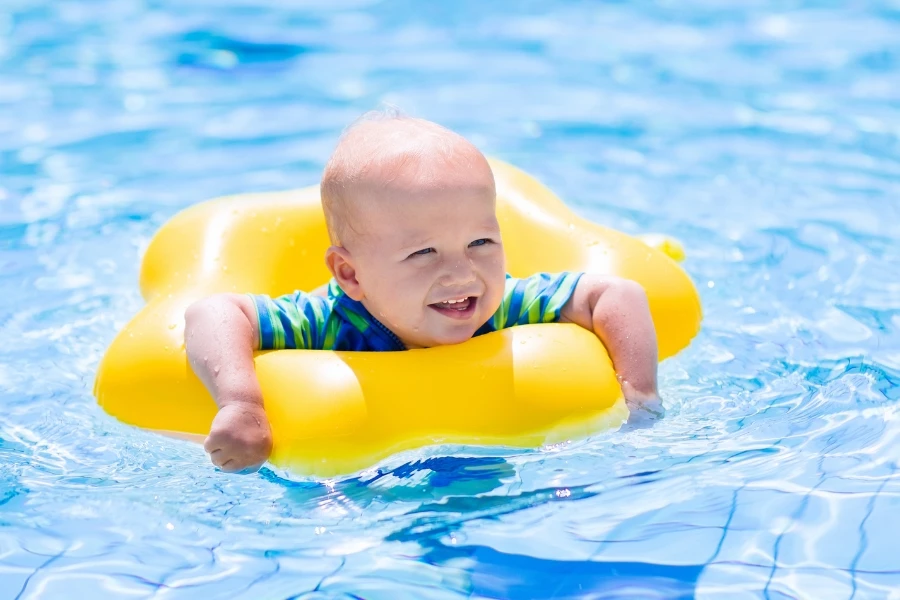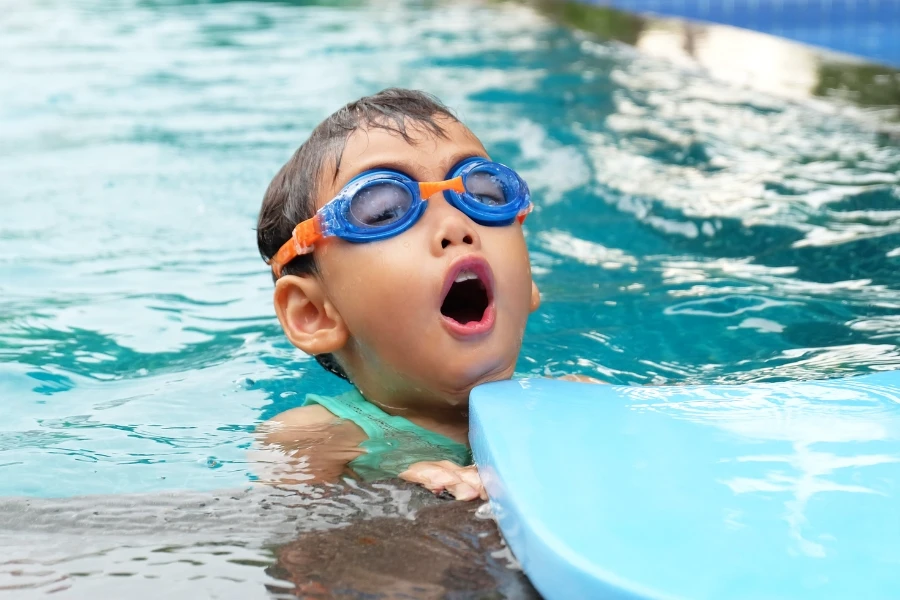
Bringing your baby into the water can be an exciting experience full of laughter, splashes, and precious memories. Swimming safety tips for babies are essential to ensure that this experience remains both fun and secure. Swimming offers more than just fun; it helps with physical development, sensory stimulation, and building water confidence. But it’s crucial to remember that safety is non-negotiable.
Babies can’t instinctively swim and are at risk of drowning, often silently and within seconds. With the right preparation and safety practices, you can create a secure environment where you and your baby can enjoy the water and learn safety skills at the same time.

Water safety is a big deal—especially in Australia, where swimming is a way of life. Whether at the beach, by the pool, or just enjoying splash time, keeping your baby safe around water means following a few key rules.
Supervision isn’t just important—it’s non-negotiable. Anytime your baby is near water, whether at home or in a public pool, you must be within arm’s reach. Even if lifeguards are around, they’re not a replacement for your full attention. Accidents can happen fast, so staying within arms reach is the best way to prevent them.
A good swim nappy is a must if you’re taking your baby to a public pool—it keeps things clean and helps meet facility rules. These need to be tight fitting around the waist and legs. For outdoor swims, sun-protective swimwear, like rash vests, can help shield their delicate skin.
As for floaties and water wings? Skip them. They can create a false sense of security. We have a video about this on our YouTube channel, which you can watch by clicking here.
If you’re heading into deeper water, Australian safety experts recommend using a proper infant life jacket instead—it keeps your little one safer without interfering with their swimming skills.
Not all water is the same. Pools, lakes, and beaches each come with their own risks, so it’s important to check for temperature, currents, and hidden hazards like sharp rocks or deep drop-offs. Natural water conditions can change fast, so staying aware makes all the difference. By staying alert, using the right gear, and knowing what to watch out for, you can make water time both safe and fun for your baby. After all, swimming should be about happy memories—not close calls.

Drowning can happen in seconds, so constant, active supervision is a must whenever your little one is near water, but so is setting yourself up for success by creating a water-safe environment. Here are some tips if you are like many Australians and have a backyard pool.
A proper barrier can be a lifesaver, literally. To keep your baby or toddler from accidentally wandering into the water, make sure your pool is enclosed on all four sides with a fence that’s at least 1.2 meters high. It should have a self-closing, self-latching gate that swings outward. And whatever you do, don’t prop the gate open—not only is it dangerous, but in many places, it’s also against the law.
Keep the area around the fence clear of anything a child could use to climb over, like chairs or potted plants. While things like door alarms or pool alarms add an extra layer of safety, they should never replace direct adult supervision. If there’s water, an adult should always be present.
Pool toys can make swimming fun, but they can also pose a risk if left in the water. Brightly coloured floaties, inflatable animals, or even small rings can tempt little ones to reach for them, leading to an accident. The best rule? Always remove toys from the pool when they’re not in use. By staying mindful and taking these precautions, you can create a safer swimming environment for your baby while making plenty of fun summer memories.

Introducing your baby to swimming lessons is more than just a fun activity—it’s a great way to build early water confidence and essential safety skills. Plus, it sets the stage for a lifetime of comfortable, happy swimming experiences. To keep your child safe around water for a lifetime – they should enroll in swimming lessons as soon as practical. At Kirby Swim, we start our baby swimming lessons from 4-months old. If you live in Perth or Mandurah, click here to find a swim school near you and the swimming lessons on offer.
Baby swimming lessons are all about getting them used to the water in a gentle, playful way. Expect sessions to focus on floating, safety, and even a bit of submersion, all while incorporating songs and games to keep things engaging. These lessons don’t just teach basic swimming skills—they also help build early water safety awareness, which can be a lifesaver (literally) as they grow.
Babies can get cold quickly, so make sure the pool is comfortably warm to keep your little one happy during lessons. Starting early can help your baby feel more at ease in the water, turning swim time into a fun and valuable learning experience!
Picking the right swim school is a big step in your baby’s swimming journey. A great instructor doesn’t just teach babies—they also guide parents, helping everyone feel comfortable in the water.
Look for a teacher who is qualified with a National Body, and a strong background in baby water safety. If possible, watch a class before enrolling to see how they interact with little ones. A good instructor should be engaging, hands-on, and always watch the kids closely.
And if safety is your top concern, choosing a school with a solid reputation, like Kirby Swim, can give you extra peace of mind. Finding the right fit means your baby gets the best start in the water—building confidence, skills, and a love for swimming!
Swimming in open water is a whole different experience from a pool—especially in Australia, where beaches, lakes, and rivers can be unpredictable. Natural bodies of water come with their own challenges, so it’s important to stay aware and take the right precautions.
Unlike pools, open water doesn’t have depth markers, so it’s harder to tell how deep it is. Watch out for rocks, logs, uneven surfaces, and sudden drop-offs—they can catch you off guard. Rivers and streams often have strong currents, which can be dangerous even for experienced swimmers. And if you’re at the beach, make sure you understand rip currents—these powerful, narrow channels of water can quickly pull swimmers away from shore.
Keeping your child safe in open water starts with constant supervision—always keep them within arm’s reach. If they’re too young to swim, a properly fitted life jacket is a must, especially if you’re near deep water or boating. Stick to designated swimming areas, and if there’s a lifeguard on duty, even better. Before heading out, always check local conditions and the weather forecast—water conditions can change fast, and it’s best to be prepared. With the right precautions, you can enjoy Australia’s beautiful open waters while keeping your little one safe!
Swimming is a wonderful experience for babies, helping them develop confidence, coordination, and a love for the water. But safety always comes first. By keeping a close watch, using the right gear, choosing safe environments, and following proper precautions, you can ensure every splash is both fun and secure. Whether you’re introducing your baby to swimming lessons, heading to the beach, or enjoying time at the pool, the key takeaway is simple: stay informed, stay prepared, and always stay close. With these water safety tips in mind, you can create lasting memories while giving your little one the best start to a lifelong swimming journey.
Locations
If you’re ready to dive into swimming lessons with Kirby Swim, click on of the buttons below to either book a lesson at a location near you or view our class timetables.